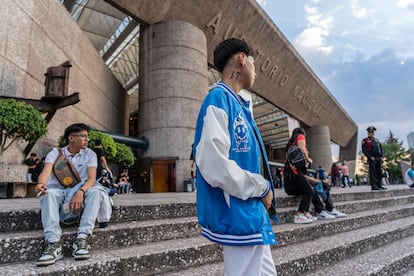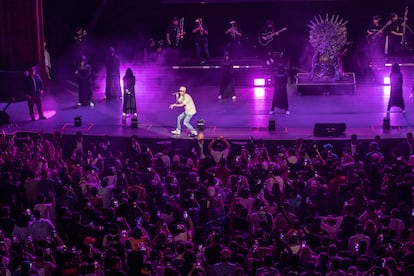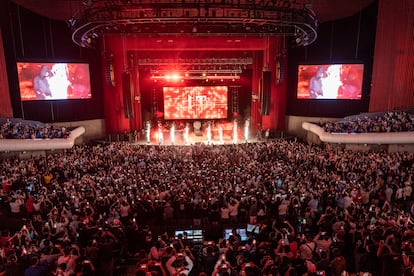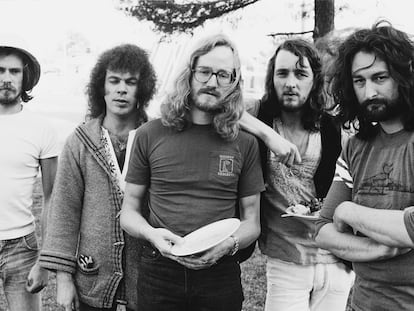Natanael Cano, the young man who wanted to change the course of Mexican music, and succeeded
With influences from trap and reggaeton, at the age of 18 he started the ‘corridos tumbados,’ an invention that has renewed the genre and catapulted it into the world charts. Today, at age 22, Cano fills Mexico’s National Auditorium

Natanael Cano’s melodious voice comes out of a small dressing room in Mexico City’s Auditorio Nacional. He sings No volveré, by Antonio Aguilar, while his musicians, huddled next to him, cover the rhythms of the ranchero classic. There are still a few minutes to go before the 10,000 people that fill the iconic venue hear his songs. During the afternoon, the area surrounding the auditorium has been filled with young people dressed in the same fashion: urban clothes with the occasional detail of the initials CT, in reference to the corridos tumbados, a variety of Mexican music. In 2019, Cano kicked off the subgenre with Corridos Tumbados, the album that has solidified Mexican music’s position on the current global scene. Cano was 18 years old at the time. It was the domino effect of a young man who covered traditional corridos in the hallways of his school.
He moves to another room backstage, and finishes singing the song a cappella. On the train of absence I depart, my ticket has no return .... He sits on a sofa. He is wearing a sweatshirt covered in rhinestones and two necklaces with even more. He takes a few sips from a half-full glass. “I’m nervous. Mexico City is always a little difficult for me. The altitude here is very different and you get tired quickly. I bought an oxygen tank to get me through the concert,” he says, as the musicians continue to pound out rhythms in the other room. In a few minutes, he will sing his corridos on the auditorium’s iconic stage, still holding his paper cup, and taking two deep breaths from oxygen cylinder, which he refers to as Marquitos.

The singer started the corridos tumbados movement when he was only 18 years old. The subgenre was being developed by artists such as Ariel Camacho and Crecer German, two of his inspirations. “A lot of people tell me, ‘Oh, I started listening to corridos because of you.’ When we were kids, corridos were not very famous, and people didn’t recognize them: nobody important sang them. Actually, my goal was to change that mentality for people of our age. We were told that corridos were looked down on, and we were excluded. I always wanted to show that corridos are fucking great,” he explains casually.
A first step
The corridos tumbados were born by adapting traditional corridos — storytelling with waltz and polka rhythms — to today’s scene, dominated by genres such as rap and reggaeton. The mix resulted in a subgenre in which pleasure seeking, drug use and war are described, which also occurs in trap music . All this with the organic sound instruments in that are typical in Mexican music: more wind in some cases (the norteño) and more strings in others (the sierreño). “I concentrated on putting other lyrics to the more youthful corridos, since I was a still a kid. I started to grab that audience’s attention. I think we’ve had a great influence in changing that part of history, in letting people know that this genre is not a joke, that it is a genre of respect. And it’s already number 1″, he says happily after seeing the success he has been reaping. Global benchmark lists like Spotify’s have accounted for this, with an unprecedented appearance of several Mexican tracks in its worldwide Top 50.
One artist whose name appears over and again in the catalog is Peso Pluma, the greatest example of the subgenre. Hassan Kabande (his real name) secured the success of Mexican music with collaborations like last Wednesday’s, with the popular Argentine producer Bizarrap. The BZRP Music Sessions Vol. 55 showcased more Mexican sounds than the electronic rhythms that the producer is accustomed to. And in less than 24 hours it had more than 20 million views on Youtube. Natanael Cano’s name has remained in the background, something that seems to create more pride than envy in him. “It gives me pleasure and I love it. In the end we are creating music in the same genre. I felt a bit bored before; there were no other artists [doing corridos tumbados], it was just me. Then these other groups come out with corridos and raised the flag, supporting what we wanted them to support. We can’t see anything wrong in that. We are grateful for everything,” he says.

Outside the auditorium, fans dressed in baseball jackets, brand-name T-shirts, sneakers and hair fades, ask Cano’s mother to take some pictures with them. The singer has invited his family and some friends. It is a special concert, and other artists will be on stage with him. In another dressing room is Yahritza Martínez, 16, and her two brothers, Armando and Jairo. Together they form Yahritza y su Esencia, a regional Mexican group that has begun to grow and has already achieved its first Gold Disc for the song Frágil. “For me, he [Cano] is an inspiration, when I was a little girl I was already watching his videos from when he played in school. And now seeing a sold out concert on such a big stage ... It’s an inspiration, really,” says Yahritza.
The first note sends the 10,000 people who have filled the auditorium into a frenzy. The singer has not yet gone on stage. The screams sound louder when Cano, glass in hand and wearing a cap that reads CT, comes on stage. He moves around the arena, climbs onto the seat decorated like the Iron Throne from Game of Thrones, says thank you and raises the flag of the corridos tumbados: “If you know it, sing along!” Halfway through the concert, he sits on the edge of the stage and sings Diamantes: Mi madre no sufre y ahora luce diferente. No se preocupa, porque ya no hay ningún pendiente. Traigo la muñeca bien repleta de diamantes... (My mother doesn’t suffer anymore, and she looks different now. She doesn’t stress anymore because there are no worries ...). His mother approaches the stage and gives him a kiss, leaving a carmine red lipstick mark on his cheek.

The boy who used to walk around school with a guitar playing songs like Virlán García’s El Gross has filled the iconic Mexico City auditorium. Along the way, there has been strong criticism of the references to drug trafficking, which have repeatedly marred the singer’s image. “I was always an artist who didn’t focus on drug trafficking. That’s why I called it corridos tumbados. They talk about my personal life, about what I’m going through. I marked that line well from the beginning,” he told the media a few months ago, when he announced his concert. In his collaborations, however, references continue to appear: JGL, the initials of Joaquín El Chapo Guzmán; Ch y la pizza, a play on words with the concept of chapiza, the armed wing of El Chapo; and the mention of firearms and descriptions of drug trafficking — Y bien forrados los paquetes van. Noy hay pendiente, no puedo fallar. (The packets are all lined up, There’s nothing left now, I can’t fail), in PRC, for example.
One more for the road
Cano officially started the corridos tumbados at the age of 18. “A lot of people give me credit for that, but in my timeline there were some artists that I recognized, but who, truth be told, couldn’t take this genre to another level. However, they are artists I admired, who worked very hard at the time. I come from there too. The only difference is that they didn’t make an international song.” The musician from Hermosillo makes reference to artists such as Ariel Camacho, who died at the age of 22 in a car accident.
The music scene in which regional Mexican music is now gathering steam has been overshadowed mainly by urban genres such as reggaeton or trap — as well as pop.
— What was your basis for changing the traditional concept?
— I wasn’t listening to music when I started writing the first albums. I was just writing my own. That helped me to have a flow, a different sound, my own thing. I didn’t know what others were putting out there at the time. When you know what’s hitting the street, you automatically go to the studio and do something similar.
There are only a few minutes before he has to go on stage. “Can you pass me the glass?” he says. He takes a final swig. He looks at one of the televisions in the dressing room. It shows Gabito Ballesteros performing, warming up the audience in the auditorium. He looks in the mirror, and combs his hair. Cano returns to the other room, where the musicians have not stopped playing. It is 8.45 p.m. He comes on stage, starts singing and the 10,000 people join in: Me la navego en todos lados, siempre con ojos tumbados. En la bola destacados, siempre piso con cuidado .... (I navigate it with eyes half-closed. Well-known in the scene, I tread carefully ...).

Sign up for our weekly newsletter to get more English-language news coverage from EL PAÍS USA Edition
Tu suscripción se está usando en otro dispositivo
¿Quieres añadir otro usuario a tu suscripción?
Si continúas leyendo en este dispositivo, no se podrá leer en el otro.
FlechaTu suscripción se está usando en otro dispositivo y solo puedes acceder a EL PAÍS desde un dispositivo a la vez.
Si quieres compartir tu cuenta, cambia tu suscripción a la modalidad Premium, así podrás añadir otro usuario. Cada uno accederá con su propia cuenta de email, lo que os permitirá personalizar vuestra experiencia en EL PAÍS.
¿Tienes una suscripción de empresa? Accede aquí para contratar más cuentas.
En el caso de no saber quién está usando tu cuenta, te recomendamos cambiar tu contraseña aquí.
Si decides continuar compartiendo tu cuenta, este mensaje se mostrará en tu dispositivo y en el de la otra persona que está usando tu cuenta de forma indefinida, afectando a tu experiencia de lectura. Puedes consultar aquí los términos y condiciones de la suscripción digital.
More information
Archived In
Últimas noticias
Maduro pleads not guilty before the federal court in New York: ‘I am still the president of Venezuela’
A new test can detect Alzheimer’s from a finger prick
UN team enters Sudanese city of El Fasher after paramilitary massacre: ‘It’s like a ghost town’
A recipe for resistance: Indigenous peoples politicize their struggles from the kitchen
Most viewed
- Gilles Lipovetsky: ‘If you want to live better and fall in love, take Prozac, don’t look to philosophy’
- Alain Aspect, Nobel laureate in physics: ‘Einstein was so smart that he would have had to recognize quantum entanglement’
- Alvin Hellerstein, a 92-year-old judge appointed by Bill Clinton, to preside over Maduro’s trial in New York
- Why oil has been at the center of Venezuela-US conflicts for decades
- Maduro’s downfall puts China’s relationship with Venezuela to the test











































